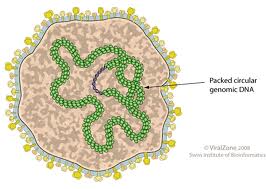The Plasmaviridae is a family of bacteriophages, viruses that infects bacteria. Virions have an envelope, a nucleoprotein complex, and a capsid. They are 50-125 nm in diameter with a baggy or loose membrane.
A bacteriophage (from 'bacteria' and Greek φᾰγεῖν phagein "to eat") is any one of a number of viruses that infect bacteria. Bacteriophages are among the most common biological entities on Earth. The term is commonly used in its shortened form, phage.
Lysogeny, or the lysogenic cycle, is one of two methods of viral reproduction (the lytic cycle is the other). Lysogeny is characterized by integration of the bacteriophage nucleic acid into the host bacterium's genome. The newly integrated genetic material, called a prophage can be transmitted to daughter cells at each subsequent cell division, and a later event (such as UV radiation) can release it, causing proliferation of new phages via the lytic cycle. Lysogenic cycles can also occur in eukaryotes, although the method of incorporation of DNA is not fully understood.
The Plasmaviridae is a family of bacteriophages, viruses that infects bacteria. Virions have an envelope, a nucleoprotein complex, and a capsid. They are 50-125 nm in diameter with a baggy or loose membrane.A DNA virus is a virus that has DNA as its genetic material and replicates using a DNA-dependent DNA polymerase. The nucleic acid is usually double-stranded DNA (dsDNA) but may also be single-stranded DNA (ssDNA). DNA viruses belong to either Group I or Group II of the Baltimore classification system for viruses. Single-stranded DNA is usually expanded to double-stranded in infected cells. Although Group VII viruses such as hepatitis B contain a DNA genome, they are not considered DNA viruses according to the Baltimore classification, but rather reverse transcribing viruses because they replicate through an RNA intermediate.
Virus classification is the process of naming viruses and placing them into a taxonomic system. Similar to the classification systems used for cellular organisms, virus classification is the subject of ongoing debate and proposals. This is mainly due to the pseudo-living nature of viruses, which are not yet definitively classified as living or non-living. As such, they do not fit neatly into the established biological classification system in place for cellular organisms.
A bacteriophage (from 'bacteria' and Greek φᾰγεῖν phagein "to eat") is any one of a number of viruses that infect bacteria. Bacteriophages are among the most common biological entities on Earth. The term is commonly used in its shortened form, phage.
Lysogeny, or the lysogenic cycle, is one of two methods of viral reproduction (the lytic cycle is the other). Lysogeny is characterized by integration of the bacteriophage nucleic acid into the host bacterium's genome. The newly integrated genetic material, called a prophage can be transmitted to daughter cells at each subsequent cell division, and a later event (such as UV radiation) can release it, causing proliferation of new phages via the lytic cycle. Lysogenic cycles can also occur in eukaryotes, although the method of incorporation of DNA is not fully understood.
The Plasmaviridae is a family of bacteriophages, viruses that infects bacteria. Virions have an envelope, a nucleoprotein complex, and a capsid. They are 50-125 nm in diameter with a baggy or loose membrane.A DNA virus is a virus that has DNA as its genetic material and replicates using a DNA-dependent DNA polymerase. The nucleic acid is usually double-stranded DNA (dsDNA) but may also be single-stranded DNA (ssDNA). DNA viruses belong to either Group I or Group II of the Baltimore classification system for viruses. Single-stranded DNA is usually expanded to double-stranded in infected cells. Although Group VII viruses such as hepatitis B contain a DNA genome, they are not considered DNA viruses according to the Baltimore classification, but rather reverse transcribing viruses because they replicate through an RNA intermediate.
Virus classification is the process of naming viruses and placing them into a taxonomic system. Similar to the classification systems used for cellular organisms, virus classification is the subject of ongoing debate and proposals. This is mainly due to the pseudo-living nature of viruses, which are not yet definitively classified as living or non-living. As such, they do not fit neatly into the established biological classification system in place for cellular organisms.














0 komentar:
Posting Komentar